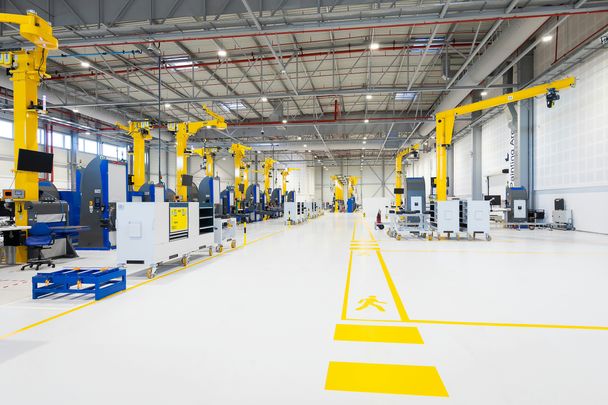A new workshop designed with safety in mind

Airbus’ approach to safety is reflected at every step from design to manufacturing, to maintenance and support. The dedicated building where the Airbus Helicopters teams produce rotors and gearboxes has become a prime example of this. This workshop is setting a new standard for production and offering an optimised working environment to keep ensuring the highest levels of safety.
Gearboxes and rotors are essential to helicopter safety, as rotorcraft have no other systems capable of taking over from these components should they fail during a flight. They have to work. This is why Airbus takes the greatest care in their manufacture and assembly.
At Airbus Helicopters in Marignane, we have a rotor and gearbox assembly workshop designed to minimise risk of human error in operational safety – for smoother assembly and higher production standards.
The new building was designed with safety in mind. The goal is to avoid mistakes, detect and correct them if they occur, and learn to continuously improve quality in assembly operations. The new workshop has been designed to create a safe and comfortable working environment for our skilled employees with specific features to limit fatigue and avoid Foreign Object Damage (FODs). Here are just some of the special modifications which set this workshop apart:
- A working atmosphere fostering serenity and optimising concentration: The temperature is capped at 26°C, it is quiet on the shop floor, and the interior has a simple decor featuring only three colours to avoid visual overload or overstimulation that might harm concentration. Artificial lighting ensures a stable light level throughout the day, whatever the season.
- Ergonomic and smart workstations: Ergonomic workstations and tools also play an important role in reducing physical tiredness. Automated articulated arms allow parts to be moved effortlessly, while digitally connected objects free employees from repetitive tasks. Connected torque spanners, for example, are programmed to tighten to the right torque. The measurements are automatically recorded in the system.
- Standardised instructions to avoid misinterpretation: Processes and instructions have also been redesigned to reduce mental fatigue. The strict processes that must be followed have been rewritten with a standardised vocabulary to ensure perfect clarity and a common understanding. Exemplary 3D models are used, representing parts and tooling for each assembly step.
- Deliver exactly what is needed, when it is needed: To further reduce the risk of human error, supplementary tasks that might disturb the operator during their assembly work have been delegated or automated. The idea is that the operator starts with exactly what they need and has nothing left over once the operation is complete. For example, all the necessary parts, components and tools required for a specific task are prepared upstream, placed in bins and distributed to each station by automated systems.
- FOD no-go zone: Giving the operators exactly what they need to do their task has another advantage. It avoids FODs, just like the RFID (radio frequency identification) chips that are used in toolboxes. These chips automatically deliver the inventory and ensure the traceability of the tools, which avoids any of them being left behind in the gearbox.
- No dust please: Even metallic dust can be considered an FOD. To ensure the cleanest possible environment, anti-FOD mats have been installed and a differential pressure system prevents particle-laden outside air from entering the building. The gearboxes are high-precision mechanisms. Every effort is made to prevent foreign bodies from lodging in them and compromising their safe and efficient operation.
The workshop redesign was made possible thanks to the efforts of the Rotors and Transmissions Centre of Excellence, which is hard at work every day to solve problems and improve how we design, manufacture and maintain rotors and gearboxes. A multidisciplinary team from design, quality, production and support was involved in suggesting and implementing the above innovations. This collaborative approach helps us to evolve our processes, to reduce errors and raise our standards.
The Centre of Excellence for Rotors and Transmissions has ushered in a new way to think, design and use assembly workshops, as far as safety and ergonomics are concerned. These new standards are now set to be implemented in our other production facilities wherever possible.



